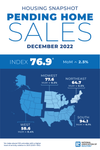FROM THE DESK OF THE CEO: A Legacy of Transformation and Warmest Wishes
I leave HGAR knowing that we are now more member-centric and innovative than ever before.

WASHINGTON—Pending home sales increased in December for the first time since May 2022—following six consecutive months of declines—according to the National Association of Realtors. The Northeast and Midwest recorded month-over-month reductions, while the South and West posted monthly gains. All four U.S. regions saw year-over-year decreases in transactions, with the West experiencing the largest decline at 37.5%.
The Pending Home Sales Index improved 2.5% to 76.9 in December. Year-over-year, pending transactions dropped by 33.8%. An index of 100 is equal to the level of contract activity in 2001. The Pending Home Sales report was released by NAR on Jan. 27.
The most recent pending home sales data prompted NAR Chief Economist Lawrence Yun to say: “This recent low point in home sales activity is likely over. Mortgage rates are the dominant factor driving home sales, and recent declines in rates are clearly helping to stabilize the market.”
Pending Home Sales Regional Breakdown
The Northeast PHSI dropped 6.5% from last month to 64.7, a decrease of 32.5% from December 2021. The Midwest index shrank 0.3% to 77.6 in December, a decline of 30.1% from one year ago.
The South PHSI rose 6.1% to 94.1 in December, dropping 34.5% from the prior year. The West index advanced 6.4% in December to 58.6, decreasing 37.5% from December 2021.
“The new normal for mortgage rates will likely be in the 5.5% to 6.5% range,” Yun added. “Job gains will steadily become important in driving local home-sales markets. The South, in particular, is set to outperform the rest of the country, thanks primarily to better job market conditions in this part of the country compared to other regions.”
New Home Sales Posts Modest Gain in December
While new home sales posted a modest gain in December, elevated mortgage rates and higher construction costs continue to hinder housing affordability and put a damper on consumer demand, according to the National Association of Home Builders.
Sales of newly built, single-family homes in December increased 2.3% to a 616,000 seasonally adjusted annual rate from a downwardly revised reading in November, according to newly released data by the U.S. Department of Housing and Urban Development and the U.S. Census Bureau. New home sales were down 16.4% in 2022 compared to the previous year.
“Builder incentives and declining mortgage rates during the month of December helped push new home sales up for the month,” said Jerry Konter, chairman of the National Association of Home Builders (NAHB) and a home builder and developer from Savannah, GA. “However, because of higher construction costs and decreasing affordability, sales are down more than 25% compared to a year ago.”
“In a further sign of decreasing housing affordability, even though the median home price is down for the second straight month, it is still up 7.8% compared to last year,” added Danushka Nanayakkara-Skillington, NAHB’s assistant vice president for forecasting and analysis. “Elevated inventories are another concerning sign of a soft market.”
New single-family home inventory remained elevated at a nine months’ supply (of varying stages of construction). A measure near a six months’ supply is considered balanced. The count of homes available for sale, 461,000, is up 18.5% over last year.
A year ago, there were just 33,000 completed, ready to occupy homes available for sale. By December 2022, that number increased 115% to 71,000, reflecting flagging demand and more standing inventory due to lower sales. Completed, ready to occupy inventory, however, remains just 15% of total inventory.
The median new home sale price in December was $442,100, down 3.7% from November, however, it is still up 7.8% compared to last year due to higher construction costs.
Regionally, on a year-to-year basis, new home sales fell in all four regions, down 8.2% in the Northeast, 22.1% in the Midwest, 13.0% in the South and 23.5% in the West.
Receive original business news about real estate and the REALTORS® who serve the lower Hudson Valley, delivered straight to your inbox. No credit card required.